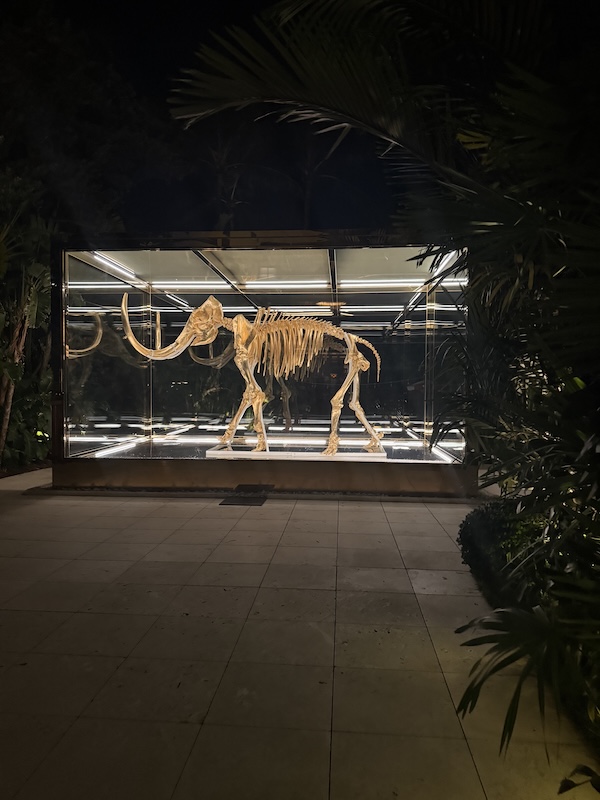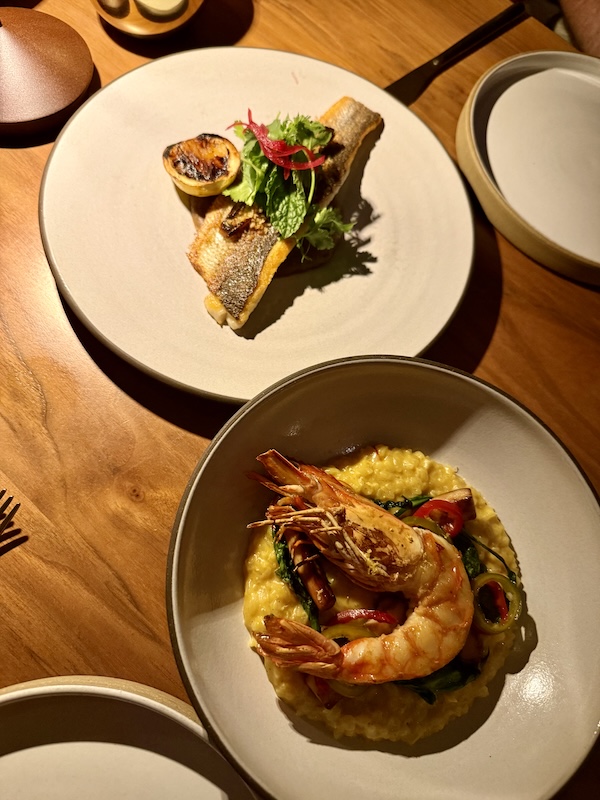After back-to-back negative experiences, it’s time to lighten things up around here! There are so many great food options in South Florida. The negative comes in at expectations unmet, especially with the increasing cost of dining out in Miami and the surrounding areas. But despite the past 2 posts, rest assured, I believe the food scene is actually good!
Pao by Paul Qui is the quintessential example of some of the best cuisine in Miam in a polished, high-energy environment. Paul Qui is a Manila-born, Texas-based chef best known for winning Top Chef Season 9 and the James Beard Award for Best Chef: Southwest. He trained under Tyson Cole at Uchi/Uchiko in Austin and blends Filipino roots with Japanese technique and a modernist streak. In 2016, he opened Pao at Faena Hotel Miami Beach.
The space glows with warm golds and deep reds, with a view line that draws your eyes toward the water. Lighting is soft but purposeful, the music has a steady pulse, and service is top-notch. In short, come for a chef with serious credentials, a room that doubles as an art installation, and a hotel that treats dining as part of a larger cultural spectacle. Innovative, interesting, and impeccable plates aren’t just hype here; they’re meals you’ll want to come back to and be thinking about long after the meal is over.
Starting with the appetizers. Pictured below, you have the Tune Crudo on the left, (ignore the middle for now), and the Grilled Broccolini on the right.
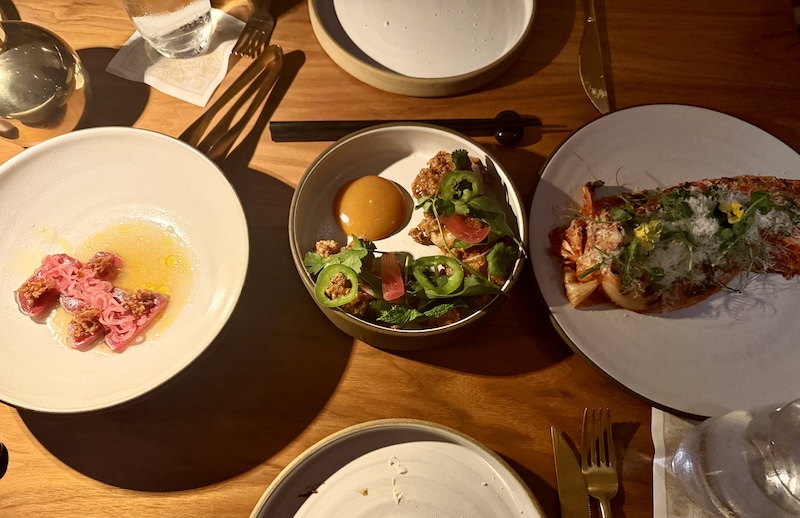
The Tuna Crudo consists of bluefin tuna, yuzu ponzu, pickled shallots, and crispy garlic.
This is the dish that tells you the kitchen cooks with intent. The tuna arrives at the perfect chill, cut clean so the texture stays supple and almost buttery. The yuzu ponzu brings bright citrus and gentle salinity that lifts the fish rather than masking it. Pickled shallots add a quick pop of acidity that resets the palate between bites. Crispy garlic provides the counterpoint the tuna needs, rounding out the perfect textures. You get silk from the tuna, snap from the shallot, echo from the garlic, and a final, savory sparkle from the ponzu. It is balanced, precise, and deeply satisfying.
Paired with the Grilled Broccolini- charred kimchi, grana padano, and key lime dressing.
This is the one misstep in an otherwise thrilling meal. The idea reads clever on paper, but the parts didn’t quite come together on the plate, which is tough to see in that terrible picture. The grill brings real smoke, and the lime dressing has a welcome lift, but bitter broccolini plus sharp citrus plus kimchi’s tang don’t taste great altogether to me.
Grana Padano, a hard, aged Italian cow’s milk cheese with a granular texture and a nutty, milder profile than Parmigiano Reggiano, adds savor but also softens the kimchi’s brightness. It is not a bad dish, just one I could have skipped amid stronger hits. Like the following favorite, the Fried Chicken:
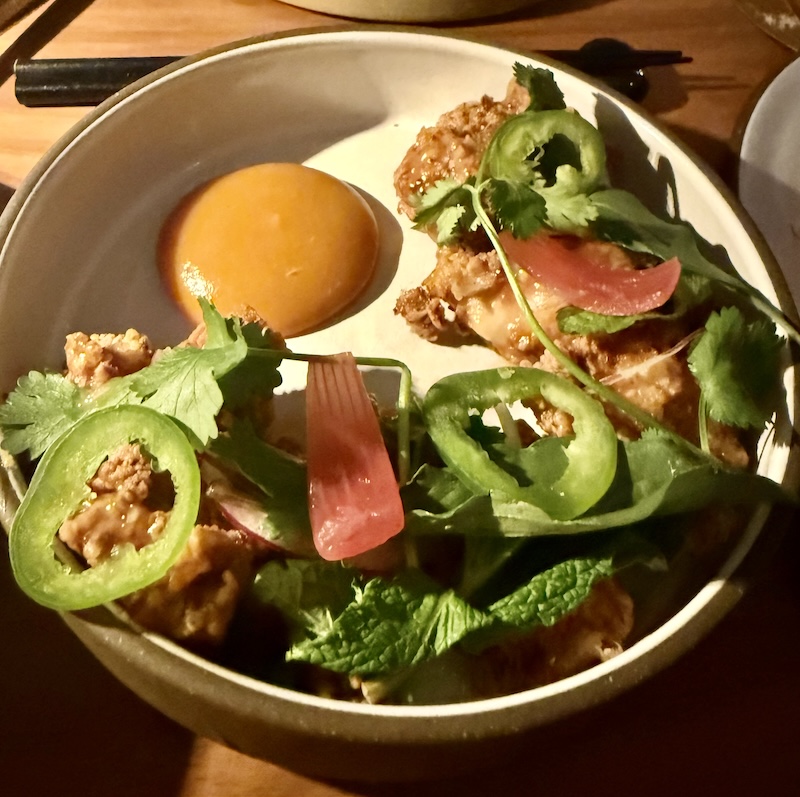
Sweet chili sauce, roasted banana ketchup, jalapeño, and Thai herbs make up this absolutely gorgeous plate. This is the plate that wins the night.
What makes this more than “just” fried chicken is how widely it resonates. Reviewers across the internet have long flagged the dish as proof of Paul Qui’s range. Yelp reviews consistently single it out, with dozens of photos and mentions that make it one of the most talked-about plates on the menu.
The sweet chili glaze lays a glossy, gentle spice; roasted banana ketchup adds a warm, fruity depth that nods to Filipino comfort; thin jalapeño slices keep things lively; and a scatter of Thai herbs cools and perfumes the finish. It’s playful and the balance holds from first bite to last. The kitchen’s description matches what lands on the table, right down to the herbs. Taken together, you get a plate that reads like Pao in miniature: technique-driven, globally fluent, and genuinely fun. If you order one dish to understand the room, make it this one.
The next course: Arroz Con Gambas. Curried rice, trumpet mushroom, tiger prawn, and pickled chilies, perfectly portioned.
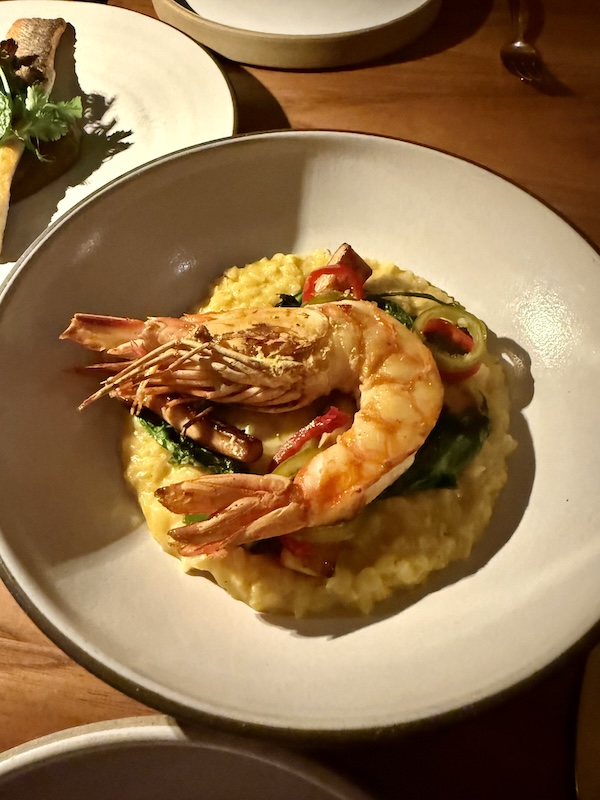
I love rice in any form. This curried rice specifically is fragrant and perfectly gauged, each grain distinct yet sauced enough to carry heat and citrus. Topped with a sliver of trumpet mushrooms that bring a meaty chew and quiet umami, the ingredients come together so well.
The tiger prawn lands snappy-sweet, cooked just to opacity. It’s not my favorite protein, so it’s very hard to impress me with this, but I was overall happy with the prawn. It works well with the pickled chilies, which cut through with a quick, clean zing. It is generous in flavor but smart in portioning, the kind of plate that leaves you energized for the next course rather than weighed down.
Our last main was the Roasted Branzino. Leek confit, roasted celeriac purée, pickled shallots, and umami crumbs complement.
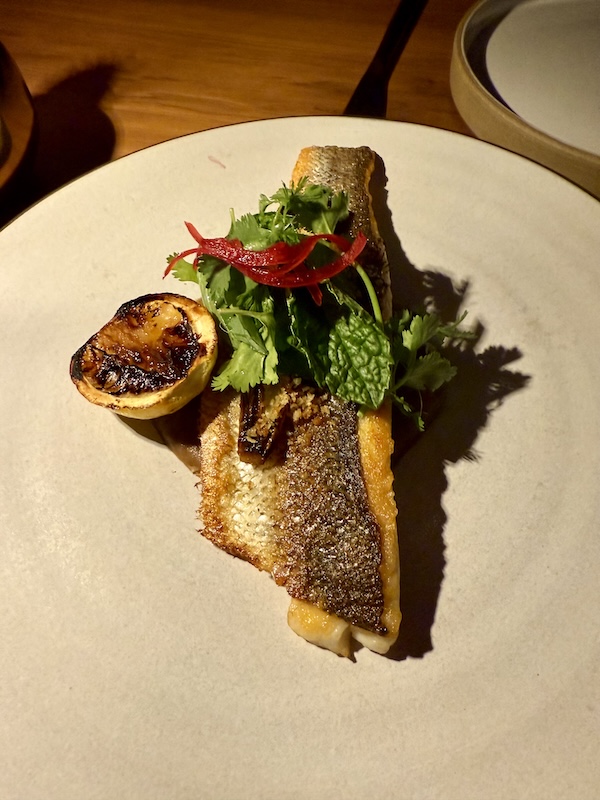
This is branzino the way it should be: skin rendered to a glassy crackle, flesh pearly and just-set, seasoned but restrained so the fish’s natural sweetness and gentle salinity lead. A proper roast lightly browns the fillet, then a short rest locks in juices. The first bite reads clean and oceanic, with a faint nuttiness from the pan.
The sides are thoughtful and purposeful. Leek confit, cooked low and slow until silky, brings a soft allium sweetness that cushions the fish without shouting. Roasted celeriac purée adds quiet depth and warmth, a nutty, earthy counterweight that gives each forkful body. Pickled shallots provide the essential reset, a quick, bright snap of acidity that lifts the richness and sharpens the flavors. Umami crumbs finish the bite with texture and savor, the kind of toasted, savory sprinkle that makes the skin seem even crisper and the fish more vivid.
Eat it in sequence and the dish clarifies itself. Break through the crackling skin, drag the fish through the celeriac for cream and earth, pick up a ribbon of leeks for gentle sweetness, then finish with a few pickled shallots and crumbs for snap and depth. The flavor line should move from clean and briny to nutty and plush, then pop back to bright and savory, never heavy, always balanced. A squeeze of lemon or a light citrus oil is all the sauce this needs.
And now to the good part (kidding, it was all clearly very good stuff)- dessert! And spoiler alert, it does not disappoint. Starting with one of the most unique desserts I have had in a long time.
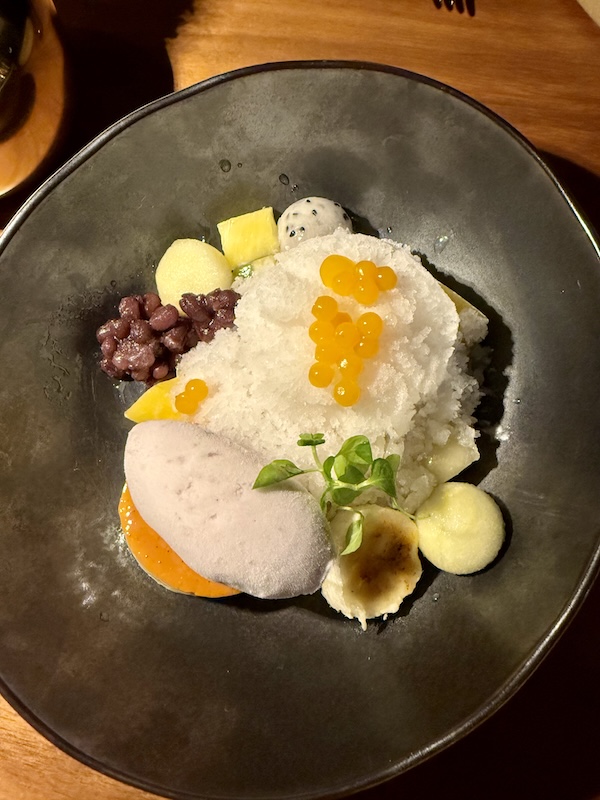
Halo halo is the Filipino answer to the question, “How do you make summer taste like joy?” The name means “mix mix,” and that is the point. It is a layered ice dessert built for contrast and play. Cold shaved ice, creamy milk, silky custard, bright fruit, and chewy-sweet bits are meant to be mixed and mingled for a flavor explosion. You pour the milk over, stir just enough to marble the layers, and chase the shifting textures as the ice melts.
This version honors tradition while nudging it forward. Classic halo halo draws on a tangle of influences that mirror the Philippines itself. Spanish-era custards give you the leche flan. American ice cream culture adds the scoop on top. Chinese and Southeast Asian pantry staples inspire the gels and jellies, while the shaved ice owes a debt to regional ices like kakigori. The soul is Filipino, rooted in merienda culture and the pleasure of mixing high and humble into something delightful.
Here, ube ice cream brings a gentle earthiness with vanilla-like warmth that perfumes the whole bowl. The leche flan is dense and glossy, a custard anchor that reads caramel and cream, and feels like an ode to Miami. Tropical fruits add lift and freshness. The kaffir lime milk is genius, turning the usual evaporated milk into something citrusy and aromatic. As you eat, the bite moves from cool and crunchy to creamy and floral, then flashes of tart fruit and caramel from the flan. This dessert is interactive, modern, and very hard to stop eating. Highly recommend, especially if it’s your first opportunity to try!
And lucky number 7, the final course and dessert: Cocoa Pod. Gianduja passion fruit mousse, and blackberry textures:
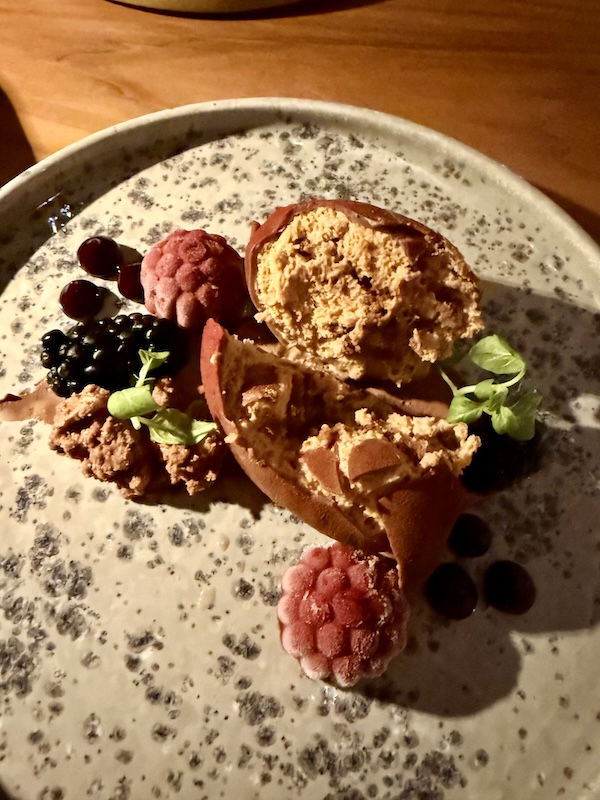
The Cocoa Pod is a showstopper and the dessert I prefer. While more familiar, it still is an innovative take on a chocolate dessert. The shell gives a clean snap, opening to a silky mousse that layers gianduja’s roasted hazelnut richness with the bright tang of passion fruit. The acidity from the passion fruit and blackberry cuts the chocolates sweetness and lets the nutty depth of the gianduja shine. Temperatures are spot on, with the mousse just cool enough to feel lush without dulling flavor.
Nothing is heavy, nothing is wasted. For anyone who loves chocolate desserts, this is that rare plate that reads indulgent and still tastes clean. Although it’s not a cold dessert, it reminds me a lot of this Chocolate Milk Cake. Not too sweet, but just right to end a wonderful meal. Here, pair it with an espresso or a small pour of aged rum or tawny port to underline the roasted notes and let the fruit glow.
And when you’re done trying half the menu like I did (which you absolutely should), enjoy the beauty of the Faena Hotel. The different spaces feature a maximalist and art-driven vision from developer Alan Faena and partner Len Blavatnik. The property is known for its big theatrical gestures, including Damien Hirst’s gilded woolly mammoth displayed on the grounds. An experience from beginning to end!
